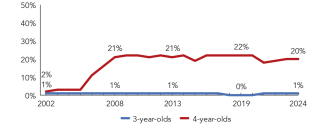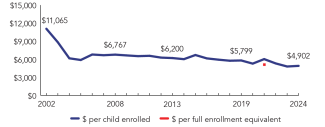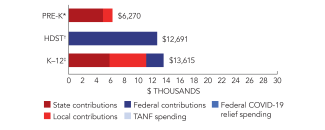
State of Preschool
Tennessee
Access Rankings
Resource Rankings
Total Benchmarks Met
Overview

During the 2023-2024 school year, Tennessee preschool enrolled 17,633 children, a decrease of 204 from the prior year. State spending totaled $86,437,438, up $835,061 (1%), adjusted for inflation, since last year. State spending per child equaled $4,902 in 2023-2024, up $103 from 2022-2023, adjusted for inflation. Tennessee met 9 of 10 quality standards benchmarks.
What's New

In the 2024-2025 school year, per classroom funding increased to $121,700. In 2023-2024, Voluntary Pre-K programs were required to choose between ECERS or CLASS Environment in order to assess the quality of the early childhood environments. These environmental observations were not required in 2022-2023. Starting in 2024-2025, all Voluntary Pre-K teachers are required to receive coaching feedback based on CLASS and CLASS Environment observations conducted by a reliably trained district staff member.
In September 2024, Tennessee was one of 10 states and D.C. awarded a 3-year federal renewal Preschool Development Grant B-5 (PDG B-5) totaling $9,000,000 annually. The PDG B-5 renewal grant is intended to carry out the strategic plans developed with the 2023 planning grants which focused on early childhood workforce, families, and access to high-quality early childhood programs and supports.
Background
Tennessee Voluntary Pre-K (VPK) was launched in 2005, building on the 1998 Early Childhood Education Pilot Project. VPK classrooms are now in 138 of the state’s 142 school districts. Children from families meeting the income eligibility requirements are prioritized for enrollment in VPK, as are children with disabilities and dependent children of a parent who died as a result of war.
The Tennessee State Department of Education and Early Learning Division have administrative authority over VPK. Only local education agencies may apply for VPK grants, but districts may contract with private childcare agencies, Head Start agencies, institutions of higher education, public housing authorities, and any community-based or private agency with a rating of at least three stars on the state’s quality rating and improvement system (QRIS) operating within the jurisdiction of the school district.
With commencement during the 2018-2019 school year, in-service professional development for directors, teachers, and assistant teachers in Tennessee Voluntary Pre-K increased from 24 to 30 clock hours per year, six of which were allocated to address developmentally appropriate literacy practices. Tennessee’s Early Learning and Development Standards were instituted in 2018. The state also continues to implement the Pre-K Quality Act of 2016, a platform for revising the Tennessee Early Learning Development Standards. This created a shared definition of “quality” to guide quality improvements, established a vision for early learning at statewide trainings, supports curriculum implementation, provides guidance for district leaders, reduced the number of approved curricula, shifted to a competitive grant application based on program quality, piloted CLASS observations, trained CLASS observers, and enforced pre-K Student Growth Portfolios statewide. Each yearly cohort of Tennessee Pre-K classrooms observed by state level CLASS observers have seen statistically significant improvements in the Instructional Support domain from fall 2020 (3.0) to spring 2021 (3.4). VPK relies on numerous funding sources, including general education revenue. Federal Head Start, IDEA, Title I, and other funds are used to provide the required local match.
Tennessee Voluntary Pre-K (VPK)
Access
Resources
| Total state pre-K spending | $86,437,438 |
| Local match required? | Yes |
| State Head Start spending | $0 |
| State spending per child enrolled | $4,902 |
| All reported spending per child enrolled* | $6,270 |

*Pre-K programs may receive additional funds from federal or local sources that are not included in this figure. †Head Start per-child spending includes funding only for 3- and 4-year-olds. ‡K–12 expenditures include capital spending as well as current operating expenditures.
Tennessee Quality Standards Checklist
| Policy | Requirement | Benchmark | Meets Benchmark? |
|---|---|---|---|
For more information about the benchmarks, see the Executive Summary and the Roadmap to State pages. | 9benchmarks met | ||
| Early Learning & Development Standards Benchmark | Comprehensive, aligned, supported, culturally sensitive | Comprehensive, aligned, supported, culturally sensitive | |
| Curriculum Supports Benchmark | Approval process & supports | Approval process & supports | |
| Teacher Degree Benchmark | BA | BA | |
| Teacher Specialized Training Benchmark | ECE, CD, ECE SpEd | Specializing in pre-K | |
| Assistant Teacher Degree Benchmark | HSD | CDA or equivalent | |
| Staff Professional Development Benchmark | 30 hours/year; PD plans; Coaching | For teachers & assistants: At least 15 hours/year; individual PD plans; coaching | |
| Maximum Class Size Benchmark | 20 (3- & 4-year-olds) | 20 or lower | |
| Staff to Child Ratio Benchmark | 1:10 (3- & 4-year-olds) | 1:10 or better | |
| Screening & Referral Benchmark | Vision, hearing, health & more | Vision, hearing & health screenings; & referral | |
| Continuous Quality Improvement System Benchmark | Structured classroom observations; Data used for program improvement | Structured classroom observations; data used for program improvement | |
